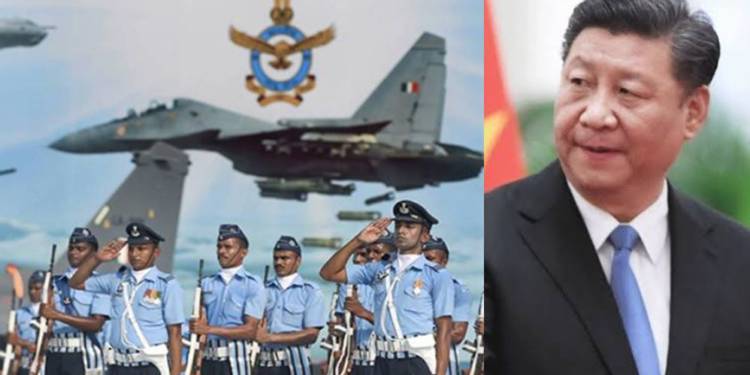China has a strategic disadvantage against India when it comes to aerial warfare along the Line of Actual Control (LAC). Since the military standoff between the two Asian giants started, there have been reports trickling in about China expanding its existing airbases which lie close to the LAC, while also replenishing them with fighter aircraft, bombers, drones and other utility aircraft. China has also placed its surface-to-air missile batteries to counter an Indian aerial offensive in the region. However, all such haphazard plans are bound to be foiled by the Indian forces, which enjoy distinctive advantages both on land and in the skies.
A Hindustan Times report quoted a top Indian Air Force officer explaining what the Chinese offensive, when seen to be taking place, would look like. According to the IAF officer, a Chinese offensive is likely to involve troops moving forward under a barrage of artillery and rocket cover fire, with surface-to-air missile batteries giving protection to their weapon systems from IAF attacks. However, the Indian army is more than capable to repulse all such moves of the Chinese.
The Chinese airbases along the LAC, Hotan, Lhasa, Gargunsa, Shigatse or Kashgar to name a few, are all located at tremendous Himalayan heights, which makes aerial combat for China a nightmare, especially against India, almost all of whose bases are located in the plains, or at heights much lower to those of the Chinese.
As such, while the Indian Air Force fighter aircraft will reach the LAC much quicker, the Chinese fighters will have a mountain of troubles even in getting their lethargic jets to stay in the air for more than an hour.
The Chinese airbases being located at unfeasible heights, with rarefied air, adversely affects the PLAAF’s prospects of waging an aerial war with India as equals. The Chinese fighter aircraft, taking off from such immense heights, cannot match their Indian counterparts in either payload capacity, or fuel-efficiency, The Chinese fighters will have to compromise heavily on the payload that they carry, while also remembering constantly that the fuel efficiency of their aircraft, taking off from heights of thousands of feet, is much less.
To overcome this major problem, China has focussed its energies on the deployment of surface-to-air missile batteries, which can act as a ground defence against the IAF fighter aircraft and their weapons. Here too, however, China is on the back foot. The senior IAF officer, speaking to Hindustan Times, explains why. The reaction of the IAF to any offensive is faster than that of the PLA Air Force due to the distance of the LAC from airbases such as Hotan, Lhasa or Kashgar. Further, PLA’s surface-to-air missile sites become vulnerable to the stand-off air-to-ground missiles of Indian fighters. “Once air-defence missile systems are knocked out, the amassed artillery, rockets and troop concentrations become exposed on the Tibetan desert, where there is no natural camouflage cover for these systems,” the officer said.
In May, satellite images had shown massive construction activity at a high-altitude Chinese airbase called Ngari Gunsa in occupied Tibet, located just 200 kilometres away from the Pangong Lake. The expansion of the airbase was believed to have been undertaken to counter the airpower asymmetry prevalent in the region in India’s favour.
The Indian Army is, in any case, the world’s best when it comes to mountain warfare, against whom the Chinese PLA does not stand a chance, as was visible from the June 15 Galwan valley clash, and also by the Indian Army and SFF operations late last month to occupy several dominating heights in the region.
While the Indian Air Force is outnumbered by the quantum of the fighter aircraft in possession of the PLA Air Force, it must be remembered that China has highly tense borders all around it, especially its Southern Theatre Command, which looks after the South China Sea and Taiwan. Beijing will not divert all its aerial force only to combat India, as that would be an open invitation for the US to alter the status quo in the South China Sea. Moreover, China cannot house all of its aerial fleet near the Line of Actual Control to face India due to lack of infrastructure.
The rapid expansion and construction of new airbases by China in the region seems to have been triggered by the drubbing they received from India at Doklam in 2017. In the past three years, China has doubled its airbases facing India, with the construction of four heliports beginning only after the latest Ladakh standoff began in May this year. Last year, China developed four airbases, four air defence sites, one heliport and one electronic warfare station. Meanwhile, China has developed four airbases, four heliports and one air defence site on the Tibetan plateau this year, the Hindustan Times reported.
As such, the paper dragon is faced with a peculiar problem, one which it cannot overcome. Even if Beijing does try to make up somehow for its disadvantages, it is outwitted and outflanked by India every time. Aerial combat, essentially, is not China’s cup of tea.
































